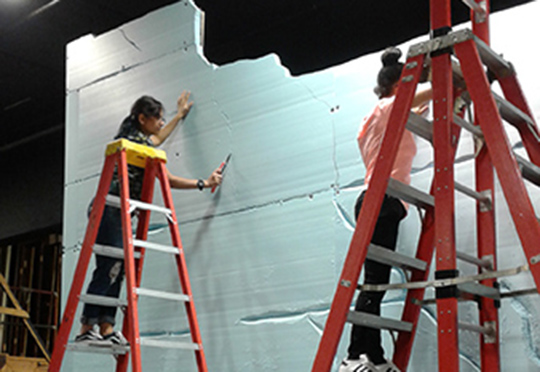 “Without the set, we don’t have an environment for the play to reside in. Scenery gives characters a home.”
“Without the set, we don’t have an environment for the play to reside in. Scenery gives characters a home.”
Associate professor of theatre and technical director Richard Wolf-Spencer handles most of the scenic designs and serves as the technical director for the theatre program at Elizabethtown College. He also teaches courses in development of theatre through lighting, sound and set building. For Wolf-Spencer, set building can be a particularly enjoyable, complex method of bringing a performance to life.
The professor takes designer plans, makes construction drawings and aids in the building process. He also is responsible for working with master carpenters, electricians and welders when it comes to individual scenic elements such as wood, lighting and metal.
Elizabethtown College theatre students also get involved as courses in stagecraft and theatrical design round out their curriculum and teach life skills in areas such as carpentry and painting.
Scenery gives characters a home.”
Depending on the play, designing and constructing a set can take months, said Wolf-Spencer, noting that the world of professional theatre has fully manned scene shops operating for several hours out of the week. The education world, however, cannot build as fast, so student assistants aid Wolf-Spencer as theatre technicians. In the fall semester, students in Wolf-Spencer’s stagecraft class fulfill lab hours with set, and technical design and paid student assistants take on the roles of painters, carvers and decorators
Senior theatre performance major Amber Mangabat, one of Wolf-Spencer’s current student assistants, joined the set building team last year after becoming interested in the hands-on process of theatre. Since then, she has dubbed herself the “queen of the paint shop,” using faux techniques to make flat pieces of wood look like marble and other materials.
Of all the sets she has designed, she is most proud of her work for E-town’s 2016 production of “Spring Awakening” for which she used dry-brush highlights and dark streaks onto a bridge to make it look weathered.
For the upcoming performance of “Medea,” Mangabat applied paper and cloth to the set to create a sand look-alike. “You get up really close and say, ‘this does not look perfect’,” Mangabat said, “but being able to step away and hear people compliment it is an awesome feeling.”
Mangabat plans to use these skills after graduation, as well, she said. “Even the simple stuff I’m doing … the simple painting techniques, can always be used somewhere.”
“One of the joys of set construction is that we work with a variety of materials,” said Wolf-Spencer. The students, he said, work with metal, plastics and wood to turn blocky hunks of material into structural and artistic elements, such as platforms and functioning stairs.
Besides the beneficial learning outcomes, Wolf-Spencer said, the design and construction process, itself, is an enjoyable one. “Seeing the progression can be really fun.”
The most recent set — E-town’s production of “Medea” — combines elements of Greece and Scotland, with a coastline set designed like a woodcut carving. Audience members can see the handiwork at 8 p.m. Nov. 2, 3, 4, 9 and 10 and at 2 p.m. Nov. 11 and 12.

